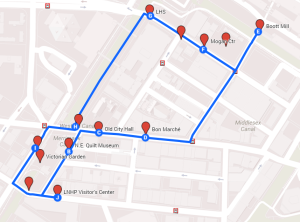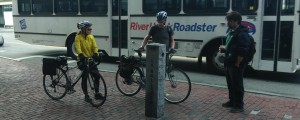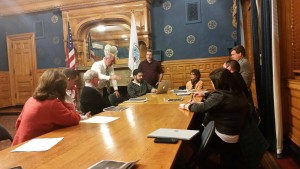The previous post discussed the DIY Lowell process of idea submission, voting, and the idea summit. This post will give an overview of the five projects coming out of the summit and where they’re at now.
Downtown History Trail
 Although the voting was close for many of the ideas, Downtown History Trail was the exception: it was the most popular idea by many votes. It attracted a pool of talented individuals, some more experienced than others. They felt they got a slow start because they spent much of the kick-off summit discussing an appropriate scope for the project—where the trail should go, whether it should have a mobile phone app, and it should be marked. Because of that, they had another session very soon after the first where they picked roles based on their interest. From there on out, they met about once every three weeks to a month to update one another on their progress and make decisions.
Although the voting was close for many of the ideas, Downtown History Trail was the exception: it was the most popular idea by many votes. It attracted a pool of talented individuals, some more experienced than others. They felt they got a slow start because they spent much of the kick-off summit discussing an appropriate scope for the project—where the trail should go, whether it should have a mobile phone app, and it should be marked. Because of that, they had another session very soon after the first where they picked roles based on their interest. From there on out, they met about once every three weeks to a month to update one another on their progress and make decisions.
After discussing the trail idea with Steven Stowell, the administrator for the Lowell Historical Board, and a group of park rangers at Lowell National Historical Park, they sketched out a trail based on the original plans for the National Park. The trail will be sketched out with spray chalk stencils and interpretive signs will be placed at key points along the trail. Their plan was well-received at a meeting with officials from the historic board, COOL, and the National Park. They credit much of the success to having one member draft an outline of what their options were and how the project could be phased—so they could concentrate on the first steps while keeping larger-scale ideas on paper for future years.
Planting Fruit Trees
The planting fruit trees group had a different experience. This group’s idea was to find a space—public or private—to plant a fruit tree that the community could support and that would provide free food for neighbors. With the success of one site, they might be able to replicate it throughout the community. Although the group generated some great interest at the summit, they were unable to find a time to meet afterward. After several months, the group reconvened, but lost a few members. Despite this, the group made great progress by meeting with key individuals, such as Jane Calvin at the Lowell Parks and Conservation Trust. She pledged a sapling donation, and the group leader was able to re-energize the group by making a formal announcement at the film screening of “The Fruit Hunters,” co-hosted by Lowell Parks and Conservation Trust. The leader says they “got a GREAT show of support with folks signing on to learn more and be a part of it.” Their next steps are reaching out to private land owners.
Bus Stop Libraries
The Bus Stop Libraries group faced similar problems with finding an initial meeting time. The idea was to install one or more waterproof cabinets stocked with books at bus stops, so bus patrons could take or leave books as they waited for the bus. They coordinated through Facebook, which turned out to be a great spot to brainstorm ideas, but the group found it difficult to make progress from that stage. Once again, they found meeting with key individuals and institutions to be the way forward. They’re gathering information from Jeanne D’Arc Credit Union, which has sponsored similar “Little Free Libraries” at the Boys and Girls Club and Rotary Park.
Artistic Bicycle Racks

Members of the Bike Rack group–and Eric Sack of Lowell Makes–surveying locations downtown with City of Lowell staff.
The wildcard group ultimately split into two smaller groups, each pursuing a project. The Artistic Bike Rack group was composed of members of the Lowell Bicycle Coalition and others who were interested in the idea of promoting bicycling and art downtown. Their idea was to install one or more bike racks that would be works of art in their own right and provide a safe spot to park bicycles.
They set their first meeting soon after the summit, and sketched out a plan of what they would need as soon as possible: funding, design guidelines, a call for artists, and locations. Each group member pursued one of those action items. The group had regular meetings between once and twice a month so that members could update on progress along with setting up a “google group” so that any one member could email all the other members in the group.
With an initial push to get basic introductory text put together as soon as possible, that text was used to set up a GoFundMe page in which the group has raised more than $1,500, and a winning grant application to the Lowell Cultural Council (and several other grant applications). The group recently closed their call for artists and formed a partnership with Great Lowell Technical High School, who may fabricate the bicycle racks with artist designs if the artist is unable.
View from Christian Hill
The View from Christian Hill group was the other wildcard group, and they successfully organized a viewing party at the reservoir of Christian Hill. The group was small, but the idea was simple: bring a few telescopes to the reservoir, print out a few guides of interesting sights one can see from the hill, bring some food, and advertise via Facebook and word of mouth. This drew more than 30 people to the hill, talking about the neighborhood, meeting neighbors for the first time, and learning more about DIY Lowell.
With the overview of groups complete, our next posts will dive into different lessons each project group is learning along with the lessons we’re learning as a fledgling organization. We hope you’ll stay tuned! We welcome any questions and suggestions for future posts.



